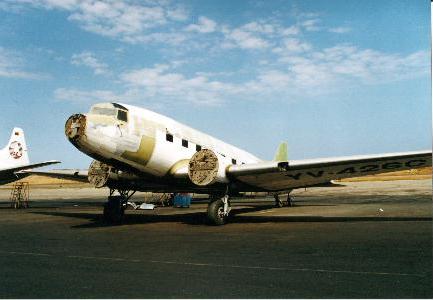
Jan Koppen describes the current piston-powered airliner scene in Venezuela and how a dwindling number of DC-3 operators are struggling to keep these propliners alive.

When working for KLM Cargo one is always surrounded by modern jets. Once a while the need for some aviation nostalgia must be fulfilled. Nowadays the choice is limited. Fortunately Venezuela is a land with still a good number of operational second generation jets and a reasonable number of Propliners. At Caracas, Simon Bolivar International Airport the sky is not polluted by whispering Airbus's and new generation Boeing 737s. Here the screaming P&W JT8Ds of the venerable Douglas DC-9s and Boeing 727s still dominates the air !
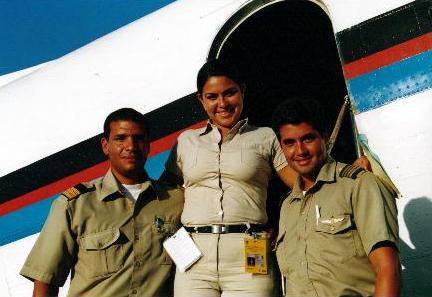
The DC-3 is the backbone of their fleet
Both Servivensa and Aeroejecutivos operates daily scheduled DC-3 passenger services from the Caracas area. Servivensa has a daily service from Caracas Charavalle to Canaima, via Ciudad Guayana (also called Pto. Ordaz). Aeroejecutivos flies twice daily from Maquetia (Caracas International) to the nearby tiny island El Gran Roques. I was determined to jump seat on both.
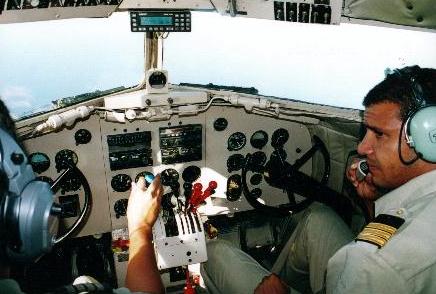
Early morning departure from Charavalle
The small town of Charavalle is located in the hills, some 50 kilometers south of Caracas city and is easily to reach by a two hour taxi-drive from Maquetia. After a short nights sleep in ‘Hotel Cockroach’ I scrambled in a dilapidated taxi to the small airport of Charavalle to catch Servisensa’s 07.00 o’clock flight to Canaima, with an intermediate stop at Ciudad Guayana. In the operations-room I soon met the flight crew for flight VC602. In command of the flight was Captain Alvaro Levanti (66) from Cuidad Bolivar. His experience of propellor-driven aircraft was impressive having flown DC-3s, Curtiss Comando’s, Viscounts and Constellations for various Venezuelan airlines. He had stopped counting his flying hours many years ago. With such a record he seemed well qualified for the task ahead. The much younger Oscar Lameda was his co-pilot.
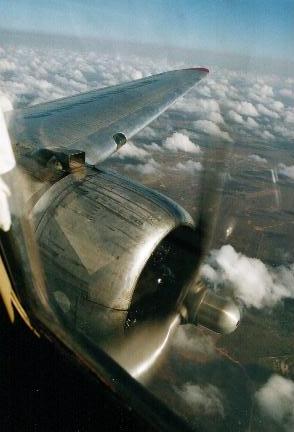
SERVIVENSA - Servicios Avensa, S.A.
On the ramp sat the pristine Douglas DC-3C YV-822C in a early morning sun. In her blue and white colors of Servisensa, she is truly an impressive sight.
This aircraft was completed in 1943 and delivered new to the 9th Air Force as a C-47-DL. In 1947 she was sold to Panair-do-Brasil. From 1958 she went on to serve with a variety of small airlines over the next ten years. During the early nineties she was sold to SANSA of Costa Rica and registered TI-SAG. Finally she was purchased by Servivensa in 1999.
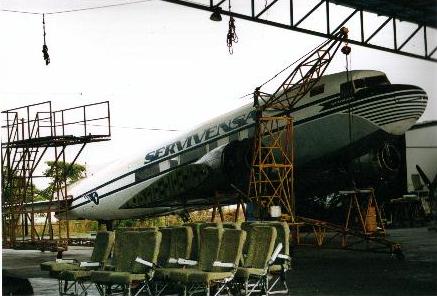
Removing the gust-locks
I was introduced to the aircraft by Captain Levanti. The first chore of the day involved the pre-flight inspection of the DC-3. Removing gust-locks, checking engine oil and fuel levels, and checking the overall airworthiness of the aircraft. Once these checks have been completed, we entered through the small door, mid-way between tail and wing. YV-822C is configured with seven rows of seats two abreast on each side of the fuselage. Rather than joining the rest of the passengers, I made my way forward into the cockpit and took my place on the leather-covered, tube-framed jump seat behind the pilots. The instrument panel, for the most part, has been updated with advanced radios and instruments. The overhead switches, cowl flap controls, flap and landing gear actuator handles were 1940’s vintage. Engine start-up involved turning the master, ignition and booster switches on, setting the mixture controls to idle cut-off and cracking open the throttles. The rocker switch was positioned to the right engine and the starter switch was engaged. After counting nine blades the mixture control was set to auto-rich and the engine came to life. Captain Levanti carefully monitored the oil pressure after start-up and the procedure was then repeated with the left engine. Needless to say, each engine start-up resulted in much white smoke and loud engine sound. We taxied safely to the holding point of runway 10 and halted. Both men checked the feathering pumps. Then rpm were increased, one at a time to 2,500, with the sticks held hard back and both men clinging on the snatching columns. They still jerked frantically as Levanti ran up to static boost for the magneto checks. Everything checked out fine and it was time to fly !
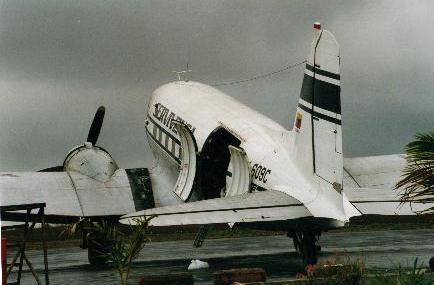
It was time to fly
This involved lining up the aircraft on the runway, locking the tailwheel, setting the friction locks on the throttles and increasing power to 2,700 rpm and 48 inch of manifold pressure. With the increased roaring sound of the two R1830s engines coming through the fuselage, ‘822C’ started to move forward and shook violently. Captain Levanti kept her pointed straight down the runway until we reached 84 knots (V1/V2). At that point he relaxed forward control pressure and she flew off the runway. Once the 91-knot single engine climb speed was indicated, Captain Levanti shouted for “Gear-up”, and Lameda released the up-locks, then hauling up the big lever on the floor beside him. At 100 knots, with the gear in transit, Levanti called for a reduction to METO setting of 41 inches and 2,550 rpm. Lameda moved the throttles and pitch levers simultaneously to the disired setting, only to be followed shortly by a climb-power setting of 35 inches and 2,350 rpm.
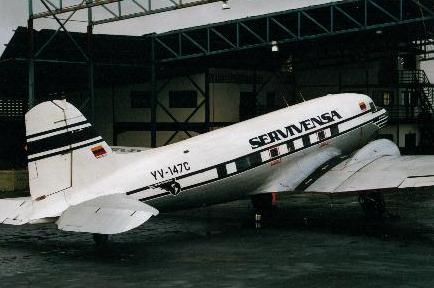
We climbed steadily to an altitude of 10,000 feet and set course for the San Tome VOR. Before long we were cruising at a healthy 135 knots on a heading of 128 degrees. I found the nose surprisingly low in the cruise and the forward view consequently very good. The predominant cockpit sound is of the slipstream rather than resonant drone of the engines.
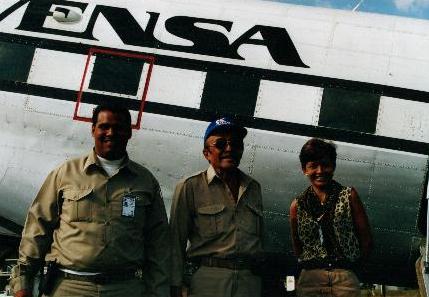
It was a beautiful day there
It was a beautiful day there, and it was great to watch Levanti and Lameda ease the old girl through the Venezuelan airways. Time passed quickly, and before long we started descent at 120 knots with 25 inches and 2,050 rpm. Shortly afterwards Levanti called for gear-down, flaps and the landing check. Minutes later we were on short final to Cuidad Guayana’s runway 07. After a single brief skip and a bit of frantic pushing and pulling, Levanti quickly edged the controls forward to pin the sturdy Douglas on the runway. Seconds later Lameda whipped up the flaps to retract them. Meanwhile Levanti started squeezing the brakes and soon we were slowed down to walking pace. Lameda opened the cowl flaps and completed the rest of the after-landing check while Levanti taxi'ied to the our assigned parking spot in front of an authentic South American terminal building
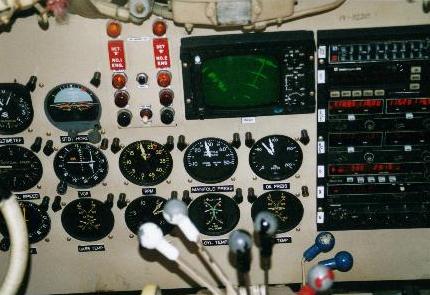
Cuidad Guayana
Ciudad Guayana is situated along the Orinoco, with many of its half a million inhabitants engaged in iron ore production.
The airport is located just outside the city and, for a small airport, has some interesting aircraft. All Servivensa DC-3s are based here and the company has a maintenance base in a corner of the airport.
During my visit YV-822C and freighter YV-609C were the only operational DC-3s.
YV-610C and YV-147C were in overhaul and YV-769C seemed permanently stored.
On the otherside of the field, in front of the barracks of the Venezuelan Navy, stood a Catalina in a very bad condition.
Next to the propliners, Cuidad Guayana is visited by DC-9s of Aeropostal, LASER and Aserca. Other visitors were several light aircraft of Rutaca, Serami, SASCA and Tranaca. The airport is also used by helicopters and light aircraft of the Venezuelan Navy.
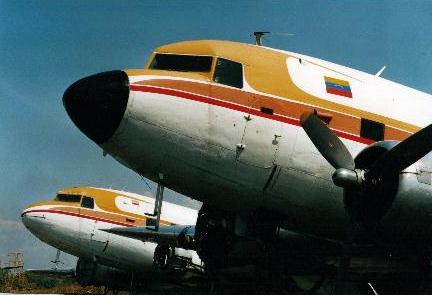
Gran Sabana
Ciudad Guayana is the gateway to the ‘Gran Sabana’. This region covers about three million hectares, making it the largest national park in the world. Its a very interesting to visit, with its legendary Tepuis, thick jungle, wild rivers, huge rapids and the world’s highest waterfall cascades, which is named the Angel Falls, after the American gold prospector who discovered them in 1937. The nearest inhabited place is the small village of Canaima which is some fifty kilometers from the falls themselves, but serves as the focal point for most tourist trips to the area. A three-day trip by boat is required to reach the falls, and so most people opt for seeing them by air only.
Servivensa operates a daily scheduled DC-3 passenger and cargo flight out of Ciuadad Guayana to Canaima and once weekly to Santa Elena de Uairen which is located at the Venezuelan/Brasil border.
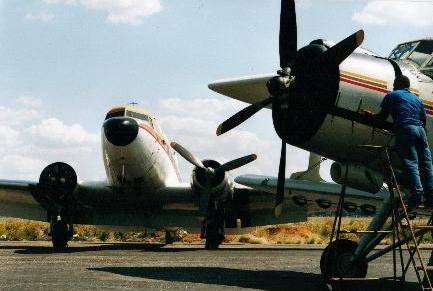
Flight to Canaima
After an hour YV-822C had been fueled up and cleaned and our time for departure came. We were escorted on board by Claudia, our attractive flight attendant. At 09.55, the new flight-crew, which consisted of Captain Luis Mujica and his 25 years old co-pilot Adrian Toro, fired up the engines and we taxied to the holding point. Adrian, as pilot in command, gently advanced the throttles before commencing the take-off run. Once airborne, we made a right turn to the south and passed over the city of Guayana. The sturdy Douglas was soon purring along in the cruise at 7,000 feet, and ten minutes later we passed over Venezuela’s largest man-made inland lake, the ‘Embalsa de Guri’. After about forty minutes in flight, one of Venezuela’s typical landmark features appeared on the horizon. Several Tepuis passed gracefully beneath the swept and dihedral wings of the DC-3. Tepuis have flat, slightly sloping peaks, with their vertical walls having been carved out by erosion over millions of years, and they rise dramatically from the jungle below. Captain Mujica pointed out to me that the Canaima airstrip was appearing on the horizon. There are no air traffic control facilities at Canaima, and pilots call ‘in the blind’ relaying their positions to other aircraft on the frequency, and seem to land in either direction as they please. We turned downwind and flew a standard circuit before lining up on final approach. With all the landing checklist itmes ticked off and the engines throttled back, we glided over the threshold. Seconds later I felt the aircraft touching the runway with a gentle bump. “ - Es el mejor - ” (He is the best), shouted Captain Mujica. His way, to express his feelings to his young co-pilot about the smooth landing ! We taxi'ied onto the small parking ramp, which was made up of red gravel and shut the engines. There was little other activity at the airstrip. The other aircraft on the ramp being a selection of Embraer Bandeirantes and Cessna Caravans belonging to another local airline, Rutaca.
Unfortunately Rutaca’s DC-3s were grounded by the Venezuelan Air Authorities after the vital crash of their DC-3 YV-224C at Ciudad Bolivar some weeks prior to my visit.
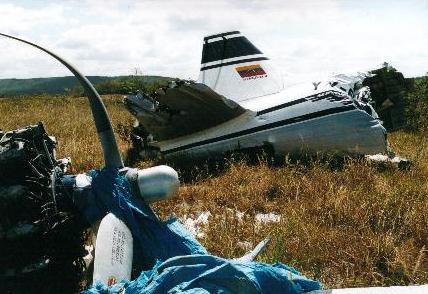
A day of a live-time
Crystal clear blue skies greeted me on the following morning and this offered a splendid opportunity for another interesting aviation activity. Besides a tourist attraction, Canaima is also used as a hub for cargo flights to the various gold- and diamond mines in the southern Venezuelan jungle. Jungle-pilots like Oca Bareto, Gonzalez Adelberto and Carlos Sanchez daily supply the ‘mineros’ with food, tools and fuel with their hardworking Cessna’s, Pipers and An-2s. After making a deal with one of the jungle-pilots, I had the oppurtunity to jump seat on several trips which initiated from Canaima. Engines were fired up and moments later we were roaring along the airstrip and soaring into the air on its way to dirtstrips near mining campsides like Playa Linda, San Agustin del Campo Grande and Uriman. I had a splendid grandstand view of the scene below and a day of a live-time ! Finally it was time to go. Via, Ciudad Bolivar, where I visited the grounded Rutaca DC-3s, I returned back to Ciudad Guayana. From here I routed back to Caracas onboard a Linea Aerea de Servicio Ejecutivo Regional DC-9-31.
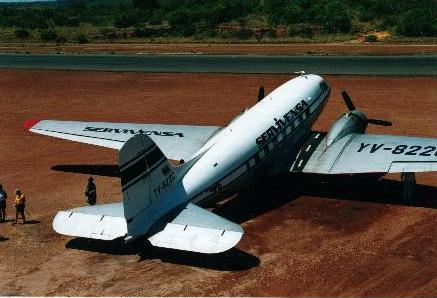
Simon Bolivar International
Next to the high-tech-jets of the world leading airlines, Caracas is still also home to a large number of second generation jets like, DC-9s of Aeropostal, Aserca and Laser, Boeing 727s of Avensa, Aeropostal, American, Mexicana and Lineas Aereas de Sudamericana, Boeing 737-200s of Avensa and TACA and DC-8s of MAS Air Cargo.
In front of Avensa’s scenic hangar a large number of jets are in store. I counted seven Boeing 727s, eight DC-9s and one Boeing 737-200 in various states of disassembly.
The days of Venezuela as one of South America’s piston-powered airliner havens would seem to be over as ATR-42s and Dash 8s abounded everywhere.
In front of the Aeroejecutivos hangar one can find their complete fleet, which consists of two operational DC-3s (YV440C and YV500C), an operational, former KLM, Convair 440 (YV-223C) and a stored DC-3 (YV-426C). Regrettably no longer operational, Rent-Avion Martin 4-0-4 YV-149C is also parked at this apron. She is still complete, but no doubt suffering under the heat of the scorching Venezuelan sun. In front of the Air Venezuela hangar were three operational Convair 580s present, of which one was in a freighter configuration. Six other were stored in a neatly line in front of the corrugated iron plated cargo warehouses. Three of them wearing the faded livery of their former operator Northwest Airlines.
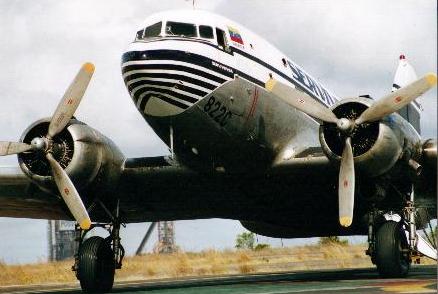
Aeroejecutivos
Inside the domestic terminal at Caracas Airport, one can find the small ticket counter of Aeroejecutivos, an small airline with a wonderfully colorful livery that operates a twice daily passenger DC-3 service to Los Roques Islands. The largest island, El Gran Roque, supports a small fishing town, beaches and a short airstrip. It is a paradise for scuba divers and sport fishermen, and for others just a rather picturesque location.
After meeting Aeroejecotivos Chief Pilot Luis Piccardo and his co-pilot Naim Marquez Martinez, I was invited along the 50 minutes flight to Los Roques. Usually, the airline’s DC-3 is parked on the business ramp, in between the executive jets. YV-440C was planned for the afternoon flight. This early production DC-3A, named ‘Caballo Viejo’, looked absolutely immaculate and stood proudly amongst the characterless sleek executive jets awaiting her passengers.
“FOUR-FOUR-ZERO-CHARLIE” history file
She was originally delivered new in February 1940 to American Airlines as NC21797 complete with starboard passenger door and Wright Cyclone engines. She was converted to DC-3A standard for Trans Texas Airways nine years later, and having retained her right hand door, she went on to serve with the famous Provincetown Boston Airlines as N31PB before she was sold to Aeroejecutivos. This aircraft has spent virtually her entire flying career hauling passengers.
Time to fly
The door closed at 16.15 local time, and we strapped ourselves in to our seats. Fortunately I was allowed to take up residence in the jumpseat. Under the watchful eye of a ground crew man armed with a fire extinguisher, Luis brought the two Pratt & Whitney Twin Wasps to life. Allowing the R-1830s time to warm up prior to departure is a very important to extend their lifecycle. As we waited, flight attendant Merluis came forward to announce that the cabin was secure and to confirm the passengers count. Once YV-440Cs engines had warmed up, we taxied out, moving gingerly on the crowded ramp. After completing engine and other pre-take-off checks, we taxied out to the ‘button’ of runway 08. Power checks were commenced, and thankfully both engines indicated that they were up to the task. At approximately 16.30, Luis eased forward the throttles, release the brakes, and we were on our way. ‘Caballo Viejo’s tail came up very rapidly and a few seconds later we were airborne. A bank to the left brought us onto a heading of 024 degrees, on course for the 80 nautical mile trip to El Gran Roque. As we settled into the cruise at 7,000 feet, attractive Merluis came up front to offer drinks, which were kindly accepted ! The roar of the R-1830s just outside the windows was not conductive to conversation, so I just watched the tops of clouds drift by as the GPS unit mounted on the instrument panel guided us straight towards our destination.
El Gran Roque in-sight
About 25 nautical miles from El Gran Roque, we began our descent. Far too soon the narrow strip of pavement on a tiny rock came into sight. Necks were craned to watch for any other traffic as we entered a standard left-hand circuit. Flaps were lowered in stages, followed by the landing gear. As we came in over the threshold, power was cut, and we made a smooth main wheel landing. A few seconds later, the tailwheel came down and we slowed to a halt. After turning around, we back-tracked along the runway to a small apron. An Aerotuy Dash 8 had preceded us there, and was already preparing for its return flight to Caracas. Off to one side, a Rutaca EMB 110 was also preparing for departure. We parked and Luis shut down the engines, and the passengers were allowed to disembark.
Tracking low over the azur blue waters
Unfortunately for me, our time on the ground was a scant 15 minutes. Our return trip to Caracas - now operating as “Aeroejecutivos 500” - tracked low over the azur blue waters of the Caribbean Sea and essentially retraced our outward journey. The sun was almost set as we neared Caracas and we began our descent well before reaching the coastline. The tower vectored us for a left base to runway 09. As we turned onto final, the approach lights confirmed we were right on the glideslope. With a characteristic squeal of tires, we were back on the ground.
Reflections
As we were taxiing back to our parking spot, I reflected on what a great week it had been and how lucky I had been to be able to fly such historic airliners.
I would like to thank the hospitable people at Servivensa and Aeroejecutivos for their kind support.
DC-3's in Venezuela
YV-13C 11865 LAV. Stored Sufi.
YV-146C 9392 Rentavion. Stored Higuerote.
YV-147C 25278 Servivensa, Puerto Ordaz.
YV-218C 43079 Rutaca, Ciudad Bolivar.
YV-222C 7386 Rutaca, Ciudad Bolivar.
YV-224C 19055 Rutaca, Ciudad Bolivar. Written offf on take-off 1/01.
YV-226C 19121 Rutaca, Ciudad Bolivar.
YV-227C 19000 Rutaca, Ciudad Bolivar.
YV-426C 4093 Aeroejecutivos. Wreck Caracas.
YV-440C 2201 Aeroejecutivos, La Carlotta. Sold to American Airlines.
YV-500C 6135 Aeroejecutivos, La Carlotta.
YV-609C 43087 Servivensa, Caracas.
YV-610C 9894 Servivensa, Caracas.
YV-670C 13074 Aerovenca, Maiqueta, La Guaria.
YV-769C 19513 Servivensa, Caracas.
YV-822C Servivensa, Caracas.
YV-911C Caribbean Flights. Stored Valencia.
YV-912C 25951 Caribbean Flights.
YV-C-AKE 4705 Air Force Museum, Maracay.
YV-C-ANI 42960 Air Force Museum, Maracay. Nose only.
YV-O-MC1 19335 Museum of Transport, Caracas.
YV-O-MTC-12 4234 Wreck at Simon Bolivar airport, Caracas.
YV-T-RTC 12386 Escuadron Legendario, Base Aerea El Libertador, Palo Negro, Aragua.
4984 4984 Air Force Museum, Maracay.